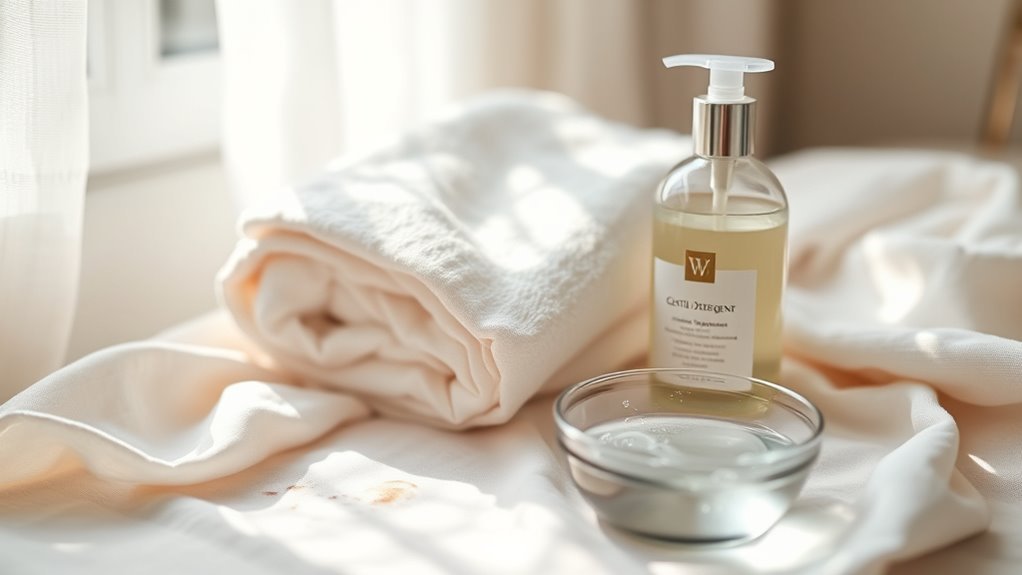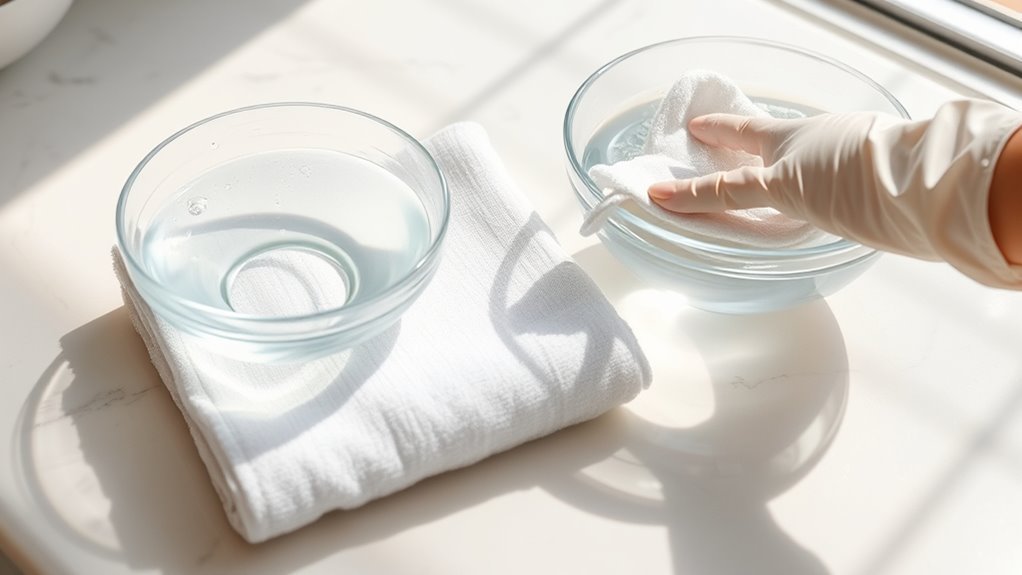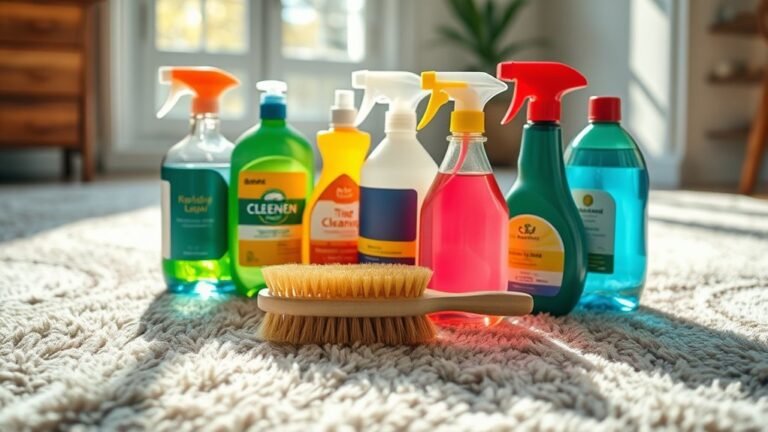Cleaning Makeup Stains From Towels and Linens
To clean makeup stains from towels and linens, first identify the stain type—foundation, lipstick, or mascara—to pick the right pre-treatment. Gently blot stains with cold water and apply mild detergent or rubbing alcohol for stubborn marks. Use gentle detergents to protect fabric fibers, and try homemade solutions like baking soda paste or white vinegar for tough spots. Air dry to preserve softness and avoid heat damage. If you want to keep your fabrics looking fresh and avoid future stains, there’s more helpful advice ahead.
Identifying Different Types of Makeup Stains

When you’re dealing with makeup stains, the first step is figuring out what type you’re up against. Foundation stains often look like oily or creamy patches, usually beige or skin-toned, and they soak into fabric quickly. Lipstick smudges, on the other hand, are more vibrant and waxy, ranging from deep reds to bright pinks. Knowing these differences helps you tackle each stain effectively without wasting time or resources. You want your towels and linens clean, free, and ready to support your lifestyle without limits. By recognizing foundation stains versus lipstick smudges, you gain the freedom to choose the right cleaning approach, ensuring your fabrics stay fresh and stain-free without hassle. Identifying the stain accurately sets you up for success every time.
Pre-Treatment Techniques for Makeup Stains
Once you’ve pinpointed the type of makeup stain, it’s time to tackle it with the right pre-treatment methods. Start with a quick stain assessment to determine the best approach. Remember, fabric compatibility is key—delicate linens need gentler care than sturdy towels. Here’s a quick guide to help you get started:
| Makeup Type | Pre-Treatment Method |
|---|---|
| Foundation | Blot with cold water, apply mild detergent |
| Lipstick | Dab with rubbing alcohol, rinse |
| Mascara | Use liquid detergent, gently rub |
| Powder | Brush off excess, soak in detergent solution |
| Eyeliner | Spot treat with stain remover, rinse thoroughly |
Using Gentle Detergents for Sensitive Fabrics

Although tougher stains might tempt you to reach for strong cleaners, using gentle detergents is essential for sensitive fabrics to prevent damage. When dealing with delicate towels and linens, opting for gentle detergent options helps maintain their softness and integrity. Harsh chemicals can weaken fibers, causing wear and fading over time. Instead, choose detergents labeled for sensitive fabric care, which are free from dyes and strong fragrances. These products effectively lift makeup stains without compromising your fabric’s quality. Remember, treating your fabrics with care not only preserves their look but also gives you the freedom to reuse them confidently. By prioritizing gentle detergent options, you protect your belongings and avoid the frustration of irreversible damage, keeping your linens fresh and beautiful longer.
Effective Homemade Solutions for Stain Removal
If you’re looking for an effective and budget-friendly way to tackle makeup stains, homemade solutions can be surprisingly powerful. By using natural ingredients, you embrace stain removal techniques that are both eco-friendly and gentle on your fabrics. Here’s how you can get started:
- Mix equal parts baking soda and water to form a paste—apply it to the stain and let it sit for 30 minutes before rinsing.
- Dab the stain with white vinegar using a cloth, then rinse thoroughly.
- Use a small amount of liquid dish soap on the stain to break down oils, then rinse well.
- Combine lemon juice with salt for a natural bleaching effect on white linens.
These methods give you the freedom to clean effectively without harsh chemicals.
The Role of Cold Water in Stain Treatment

While homemade solutions are great for tackling makeup stains, the temperature of the water you use can make a big difference in how well those methods work. Cold water temperature helps prevent stains from setting into the fabric, giving you more freedom to remove them effectively. The cold water benefits include minimizing color bleeding and preserving fabric integrity. Using cold water is a simple yet powerful step in stain treatment that you shouldn’t overlook.
| Water Temperature | Effect on Stains | Fabric Impact |
|---|---|---|
| Cold (below 80°F) | Prevents stain setting | Gentle on fabrics |
| Warm (80-110°F) | May set some stains | Moderate wear |
| Hot (above 110°F) | Can set protein stains | Can damage fabrics |
| Cold water benefits | Saves energy | Maintains fabric color |
| Cold water temperature | Ideal for makeup stains | Safe for delicate linens |
How to Use Stain Removers Safely
Because stain removers contain strong chemicals, you need to handle them carefully to avoid damaging your fabric or irritating your skin. Following proper stain remover guidelines guarantees a safe application and preserves your freedom to reuse your favorite towels and linens.
Here’s how you can use stain removers safely:
- Always test the remover on a small, hidden area first to check for colorfastness.
- Wear gloves to protect your skin from harsh chemicals.
- Apply the stain remover directly to the makeup stain without soaking the entire fabric.
- Follow the product’s instructions precisely, including recommended wait times before washing.
Avoiding Common Mistakes When Washing Makeup Stains
When washing makeup stains, make sure you use cold water to prevent setting the stain further. Avoid fabric softeners, as they can interfere with stain removal and damage the fabric. Keeping these simple tips in mind will help you get better results every time.
Use Cold Water
If you want to keep your makeup stains from setting, you should always use cold water to rinse the affected area. Cold water benefits your stain removal efforts by preventing the makeup’s pigments from bonding with fabric fibers. Here’s why sticking to cold water is a smart move:
- It stops stains from setting deeper, making them easier to lift.
- It preserves the fabric’s integrity, so your linens stay fresh longer.
- It saves energy, aligning with your freedom to live sustainably.
- It pairs well with most stain removal techniques, enhancing their effectiveness.
Skip Fabric Softeners
Cold water can do wonders for preventing makeup stains from setting, but using fabric softeners during washing can undo your efforts. Fabric softeners often leave residues that trap makeup particles, making stains harder to remove and reducing your towel’s absorbency. To keep your linens fresh and stain-free, steer clear of traditional softeners. Instead, opt for fabric softener alternatives like white vinegar or baking soda, which soften fibers naturally without compromising towel maintenance. These natural options help maintain your towels’ texture and prolong their lifespan, giving you the freedom to enjoy soft, clean linens without chemical buildup. Skipping fabric softeners is a simple switch that empowers you to take control of your laundry routine and keep makeup stains from becoming permanent.
Best Practices for Drying Towels and Linens After Stain Removal
Once you’ve removed makeup stains, drying your towels and linens properly is key to keeping them fresh and stain-free. Air drying is gentle and helps prevent setting any leftover residue, while using the dryer on a low or delicate setting can speed things up without causing damage. Choosing the right drying method will extend the life of your fabrics and maintain their appearance.
Air Drying Benefits
Although drying towels and linens quickly might seem convenient, air drying offers distinct advantages, especially after removing makeup stains. When you choose air drying, you’re embracing fabric preservation and extending the life of your items. Here’s why air drying rocks:
- It reduces heat damage, keeping fibers strong and vibrant.
- Air drying prevents shrinkage, so your towels and linens keep their original size.
- It minimizes wear and tear caused by tumbling in a dryer.
- Fresh air naturally eliminates lingering odors, leaving your fabrics smelling clean and free.
Optimal Dryer Settings
While air drying offers many benefits, sometimes using a dryer is the more practical choice for drying your towels and linens after removing makeup stains. To keep your fabrics fresh and undamaged, choosing the ideal dryer settings is key. Opt for a medium heat or delicate cycle to prevent over-drying, which can weaken fibers and cause shrinkage. Using sensor drying, if available, lets your dryer automatically stop once items are dry, saving energy and protecting your linens. This approach not only preserves fabric quality but also supports energy efficiency, helping you save on utility bills. Remember, drying on too high heat can set any leftover stains, so lower settings give you the freedom to keep your towels and linens in great shape without extra hassle.
When to Seek Professional Cleaning Services
Knowing when to seek professional cleaning services can save you time and prevent further damage to your garments. If you want to keep your towels and linens looking fresh, consider professional cleaning when:
- Stains are stubborn and won’t lift with home treatments.
- Fabrics are delicate or expensive, requiring expert care.
- You’re unsure about the right cleaning method or product.
- You want to explore specialized service options like stain removal or fabric restoration.
Choosing professional cleaning frees you from guesswork and guarantees your items get the attention they deserve. Don’t hesitate to reach out to a trusted cleaner who can tailor their service options to your needs. This way, you maintain your freedom to enjoy spotless, well-kept linens without the hassle.
Preventing Makeup Stains on Towels and Linens in the Future
To keep your towels and linens makeup-free, try using makeup remover cloths before touching any fabric. You’ll also want to set aside separate towels just for your makeup routine. These simple habits can save you from stubborn stains down the line.
Use Makeup Remover Cloths
A simple way to keep your towels and linens free from makeup stains is to use makeup remover cloths. These cloths are designed specifically to lift makeup gently without harsh chemicals. By adopting this method, you maintain freedom from stubborn stains and extend the life of your fabrics. Here’s how to make the most of makeup remover cloths in your cleaning techniques:
- Dampen the cloth with water before use for ideal makeup removal.
- Gently wipe your face with the cloth, focusing on makeup-heavy areas.
- Rinse the cloth after each use to keep it fresh and effective.
- Wash the cloth regularly according to the manufacturer’s instructions.
Using makeup remover cloths helps you avoid makeup stains altogether, giving you easy, stain-free towels and linens.
Separate Towels for Makeup
Although it might seem simple, using separate towels specifically for makeup removal can make a big difference in preventing stains on your regular towels and linens. By dedicating a few towels solely for removing makeup, you protect your everyday linens from stubborn stains and extend their lifespan. To keep things hassle-free, integrate towel organization into your routine—store your makeup towels neatly alongside your makeup storage area. This way, you’ll always know where they are, making your skincare routine more efficient and freeing you from worrying about ruining your favorite linens. Taking this small step lets you enjoy clean towels and the freedom to experiment with makeup without the stress of permanent stains. It’s a smart, simple way to keep your space fresh and organized.
Frequently Asked Questions
Can Makeup Stains Cause Fabric Discoloration Over Time?
Yes, makeup stains can cause fabric discoloration over time if you don’t act quickly. To keep your fabrics looking fresh, you’ll want to focus on stain prevention and proper fabric care. Treat stains as soon as you notice them to avoid long-term damage. Using gentle detergents and avoiding harsh chemicals will help maintain your fabric’s color and texture, giving you the freedom to enjoy your favorite linens without worry.
Are Certain Towel Materials More Prone to Makeup Stains?
Funny enough, when you pick a towel material, you might not realize how much it affects stain resistance. Some fabrics like cotton soak up makeup stains faster, making them tougher to clean. Meanwhile, microfiber towels tend to resist stains better, giving you more freedom from those pesky marks. So, if you want your towels looking fresh without constant scrubbing, choosing the right material is key to staying stain-free effortlessly.
Does Makeup Type Affect How Long Stains Take to Set?
Yes, the makeup type definitely affects how long stains take to set. Different makeup ingredients like oils, waxes, and pigments impact stain permanence differently. For example, oil-based products tend to soak in faster, making stains harder to remove if you don’t act quickly. You’ll want to treat the stain as soon as possible to keep your freedom from stubborn marks, no matter what kind of makeup caused it.
Can Repeated Stain Treatments Damage Towel Fibers?
Yes, repeated stain treatments can affect fiber integrity, especially if harsh chemicals or vigorous scrubbing are involved. You might notice your towels feeling rougher or thinner over time. To keep your fabrics free and fresh without sacrificing their strength, try gentler stain removers and avoid over-washing. Balancing effective cleaning with fiber care helps you enjoy your towels longer, giving you that freedom to use and reuse without worry.
Is It Safe to Use Bleach on Makeup-Stained Linens?
Oh sure, you could douse your linens in bleach and hope for the best—because who doesn’t love risking fabric damage for a quick fix? But if you want your freedom from ruined fibers, consider bleach alternatives like oxygen-based stain removers. They’re gentler and still pack a punch against stubborn stains. So, instead of gambling with bleach, embrace smarter stain removal options that keep your linens looking fresh without sacrificing their lifespan.






